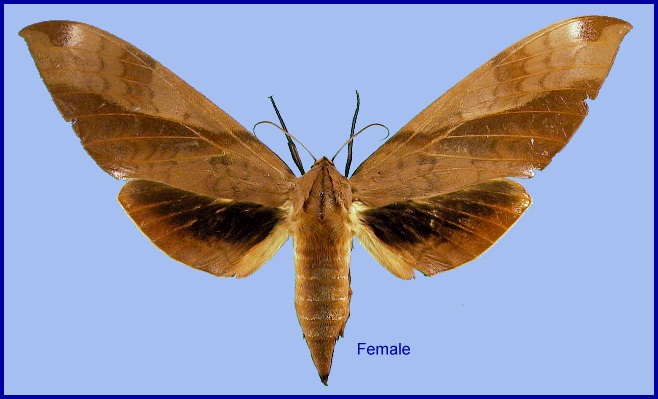
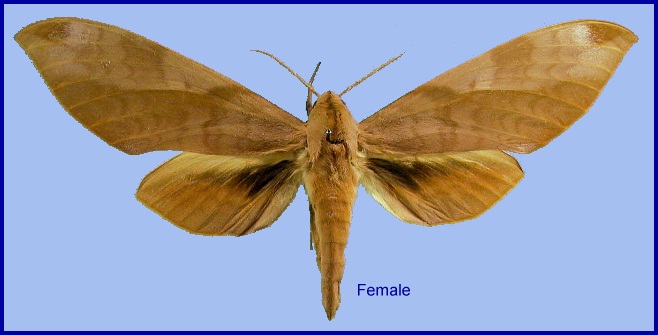
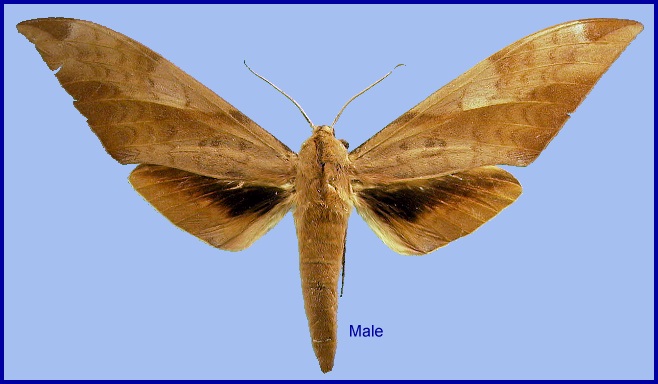
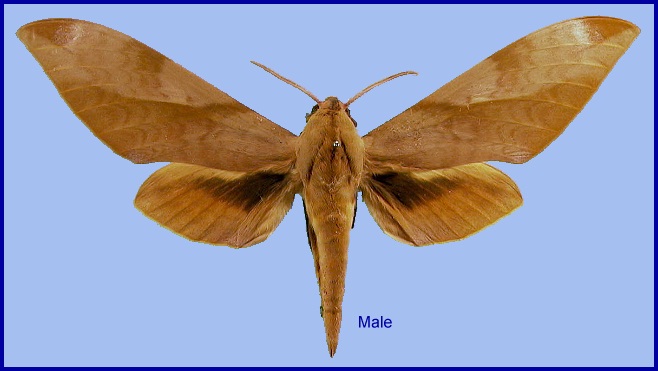
Clanis gigantea Rothschild, 1894, Novit. zool. 1: 96. Type locality: North India: Assam [Meghalaya], Khasia Hills [Khasi Hills].
Wingspan: 118--160mm. Underside of femora, inner side of anterior tibia and tarsus, upperside of mid- and hind tarsi and of antenna pink, upperside of mid-tibia and outer side of all tibiae blackish; hind tibia of male longer than that of female, as long as the first tarsal segment; spurs longer than in the other species of Clanis, the short ones over half the length of the long ones, those of the apical pair of hind tibia not so widely different in length as in other species, the longer one more than half the length of the first tarsal segment. Wings more elongate than in any other species of this genus. Distal margin of forewing in male longer than the inner margin, in female very little shorter; the lines of lunules of the forewing on the whole more strongly marked than in Clanis bilineata, with which the species has been confused by Leech & Hampson: there are in some specimens four such lines between the cell and the postdiscal line which begins at the apical patch; the black area of the hindwing is more extended than in Clanis bilineata (Bell & Scott, 1937). Dry season/region forms are much redder and paler than wet season/region forms.
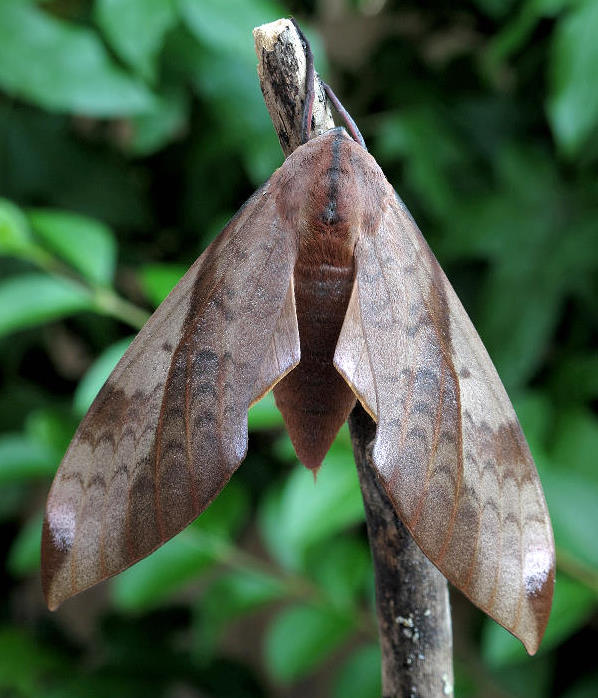
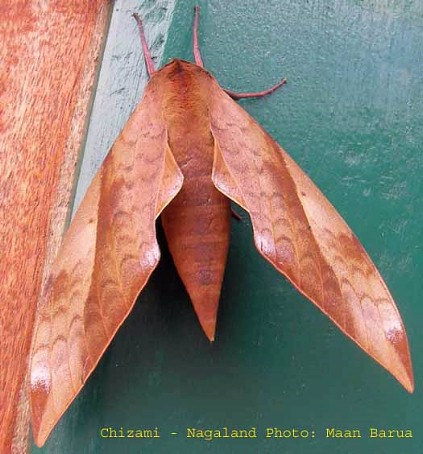
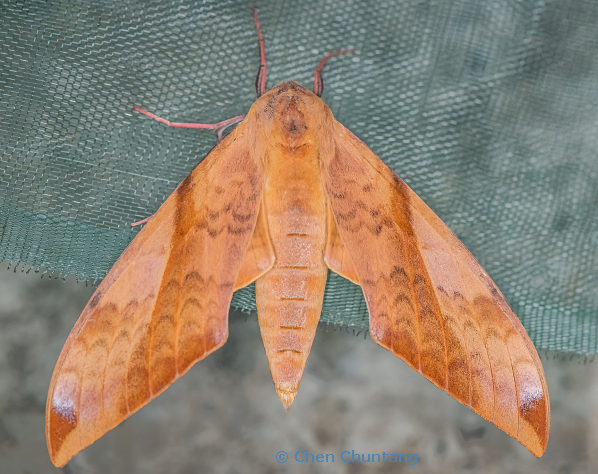
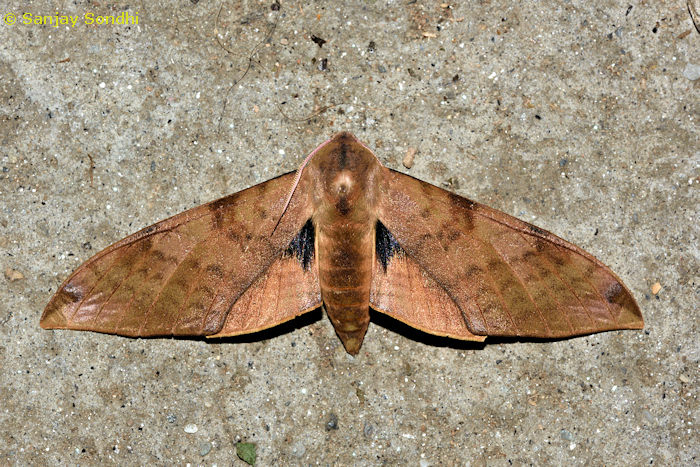
It is sluggish during the day, but can fly swiftly (Bell & Scott, 1937).
China: 5.iii-25.vi (Guangdong); v-vi (Sichuan; Zhejiang); 19-25.vi (Yunnan); 23.vi (XigazÍ/Rikaze/Shigatse Prefecture, Xizang/Tibet); vii (Hubei; Guangxi; Hunan; Yunnan); 21.vii-3.ix (Guangdong); viii (Fujian; Zhejiang).
OVUM: Ivory-yellow, slightly oval (2.0 x 2.50mm), shiny and smooth.
Eggs and larvae may be found in June and July in the Khasi Hills of India. There is only one brood in the year, the larvae hibernating.
LARVA: Full-fed 100mm; width 16mm. horn 1mm. In the first instar, head large and round, body cylindrical, of less diameter than head. Horn straight, of medium length, the tip shortly, broadly bifid. On emerging from the egg, head and body pale yellow and horn pale grey; after feeding head yellow, body yellowish-green, horn reddish-brown with a whitish median ring and the tip black. In the second instar, head broadly triangular with a process rising from the apex of each lobe, these processes half as long as rest of head and diverging from their bases. Horn straight, of medium length. Head with a line of tubercles separating face from cheek. Body with transverse rows of small tubercles, one row around each secondary ring. There are narrow subdorsal and subspiracular stripes of larger tubercles on segments 2 to 4, the latter stripe meeting the lower end of the oblique lateral stripe on 5. The narrow oblique lateral stripes are formed of larger tubercles on 5 to 11, extending backwards to near dorsal line of body, that on 11 running across 12 to base of horn. Head green, the processes red-brown, the line of tubercles yellow. Body bright green, the transverse rows of tubercles white, the larger tubercles forming the stripes yellow. In the succeeding instars there is little change, except that the head-processes and the horn become proportionally shorter and the tubercles less prominent (Bell & Scott, 1937).
By the final instar (with could be the fifth or sixth instar), head large and deep, rounded-triangular, dorsal line of vertex depressed, the processes reduced to a small tubercle on the apex of each lobe. Surface of head shiny, with a line of large, flat, oval tubercles running from the apex of each lobe to base of antenna, separating the face from the cheek; also down each side of the dorsal line from vertex to apex of clypeus and down each side of clypeus. Face covered with large, irregularly shaped, flattened tubercles which touch each other; rest of head with large, rounded, scattered tubercles. Body short and thick, nearly cylindrical; horn a conical tubercle 1 mm. long. Surface of body dull, with a transverse row of rather widely spaced tubercles around each secondary ring. There is a subspiracular stripe of larger tubercles on segments 2 to 4, meeting the lower end of the oblique lateral stripe on 5. The oblique lateral stripes are formed of large tubercles on 5 to 11, the last running across 12 to base of horn and along sides of horn to its tip. There are also large scattered tubercles on the anal flap and claspers (Bell & Scott, 1937).
In colour, head green, the stripe of large tubercles separating face from cheek, and those down the dorsal line, yellow; tubercles on rest of face steel-blue; those on rest of head yellow. Labrum, ligula and mandible reddish-brown. Body green, the transverse rows of tubercles white, those forming the subspiracular stripe on 2 to 4, the oblique stripes and those on anal flap and claspers yellow. Horn green, the stripe of tubercles yellow. True legs reddish-brown, prolegs and claspers green. Spiracles narrow ovals, whitish, with a broad rust-brown band across the middle (Bell & Scott, 1937).
The larva is very sluggish, and the growth slow. When molested it turns the face to the aggressor, the true legs bunched together under the mandibles. As with other species of Clanis, the larva does not pupate immediately after burying itself in the earth, but remains in the larval state for several months (in one case for at least eighteen months). If uncovered it is found lying in a torpid condition, the head bent round to touch the body at about segment 8 or 9. It will then slowly straighten itself and dig into the earth again. It remains in this state during the winter and then actually pupates, or, if allowed to get too dry, slowly shrivels and dies. The moth emerges 2-3 weeks after pupation finally takes place (Bell & Scott, 1937).
[A full, illustrated account of all the early stages of this subspecies is given by Eitschberger & Hoa Binh Nguyen, 2015.]
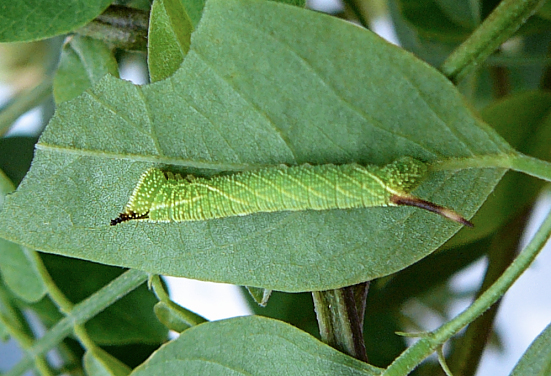
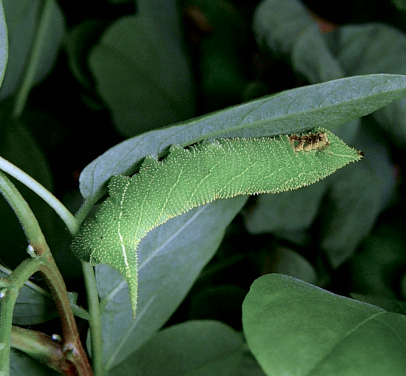
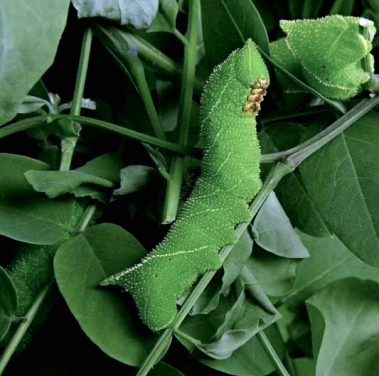
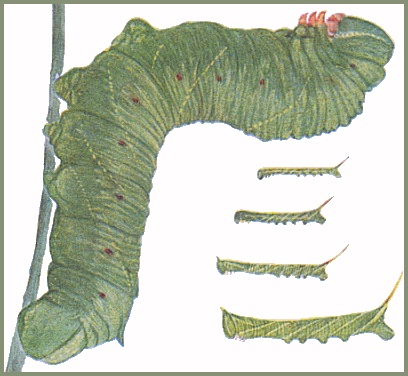
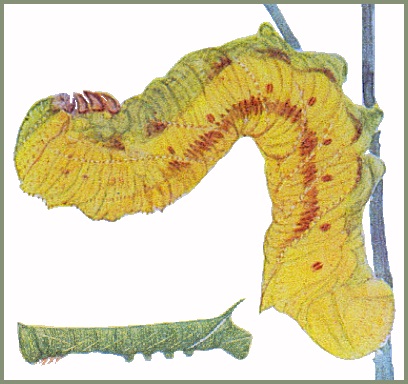
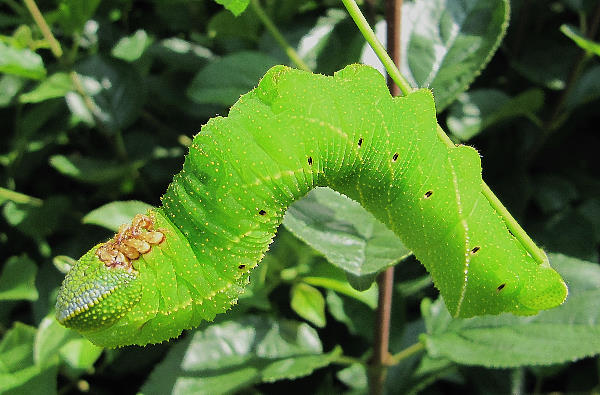
PUPA: 57mm; width 22mm. Colour a fine chestnut, bevels of movable segments paler, spiracles and cremaster black. Large, slender and shiny; length from front of pupa to end of wing-cases more than rest of pupa. Frons broadly visible from below; antenna shorter than fore leg; often with a distinct coxal piece. Frons shallowly rugose-corrugate, base of tongue minutely transverse-corrugate; costa and veins of wing obscurely beaded. Segments 4-7 with a single row of deep pits along the front margin; strong antespiracular ridges on segments 9-11; a very small spiracle visible on segment 5. Abdomen shagreened. Cremaster wedge-shaped, upturned, the lower edge of base touching clasper-scars on 14; its surface very rugose and corrugate, excepting the narrow longitudinal ridge at the end, which is smooth and shiny (Bell & Scott, 1937).
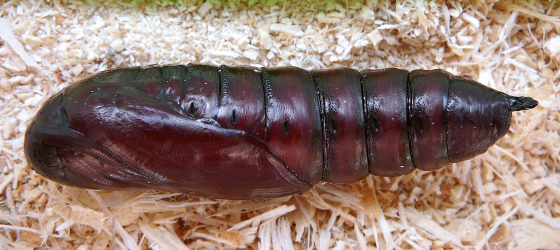
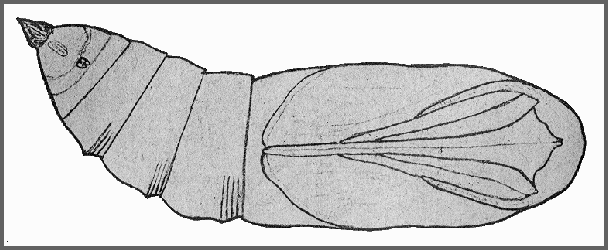

Larval hostplants. Recorded on Lespedeza in Guangdong (Mell, 1922b) and on L. thompsoni from northeastern India (Bell & Scott, 1937). Monophagous in Guangdong on L. viatorum (Mell, 1922b) (which Mell, 1935, erroneously listed as L. formosa), which is also the favoured larval hostplant in the Yangtze Valley (Yang, 1978). The record on Ligustrum (Mathur & Balwant Singh, 1960) is almost certainly an error derived from the north american species Ceratomia undulosa (Walker).
China: Anhui (Huangshan); Zhejiang (Tianmu Shan, 1600m; Mogan Shan, 450m; Kuocang Mountain Nature Reserve); Hubei (Changyang; Luotian, 1729m); Sichuan (Baoxing; Daxue Shan, Luhuo; Danba; Wolong National Nature Reserve; Xiaolou); Yunnan (nr. Lüchun, 1900m; nr. Jinping, 2155m; Gaoligong Shan; Dabaoshan, Huaping); Xizang/Tibet (XigazÍ/Rikaze/Shigatse Prefecture); Guizhou (Xinzhaidashan, Zhijin County, 1000-2000m); Hunan (Nan Ling, 700m); Jiangxi (Guling); Fujian (Guangze, 1200m); Guangdong (Lianping; Nanling National Forest Park, 1100m (Morishita & Kishida, 2000)); Guangxi (Guling); Hainan (Longhushan, Wenchang City).
The nominotypical subspecies occurs in the southern Russian Far East, the Korean Peninsula and northeastern China, as far south and west as Shaanxi and Hebei. South from Sichuan, Hubei, Jiangxi and Zhejiang, it is replaced by Clanis undulosa gigantea, which ranges west to Nepal, Bhutan (Irungbam & Irungbam, 2019) and northeastern India and south, through Thailand, Laos and Vietnam (Le & Vu, 2024), to Peninsular Malaysia.
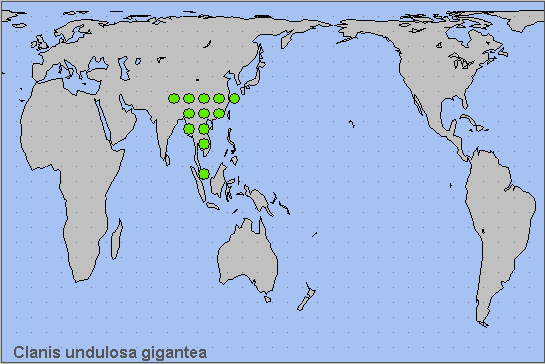
 Return to Sphingidae of the Eastern Palaearctic species list
Return to Sphingidae of the Eastern Palaearctic species list